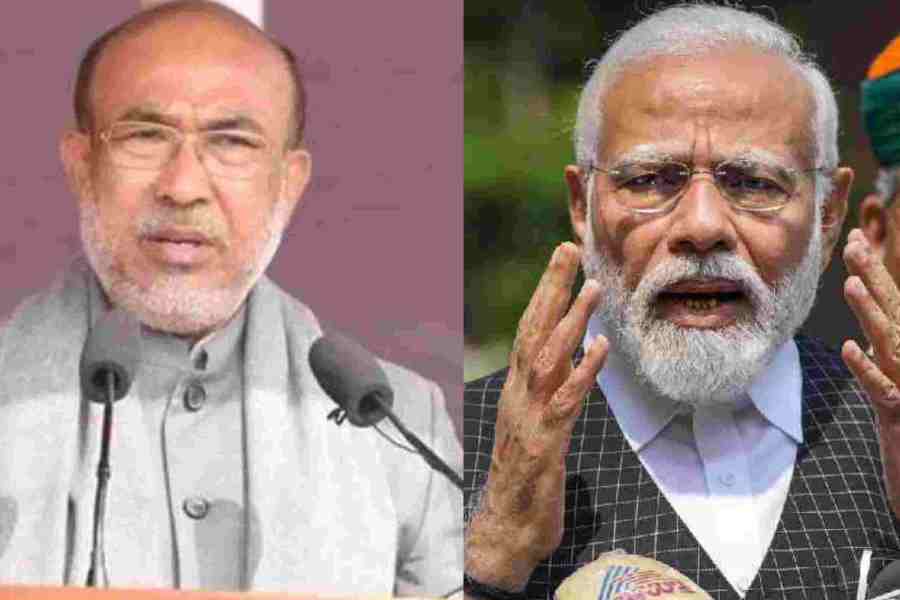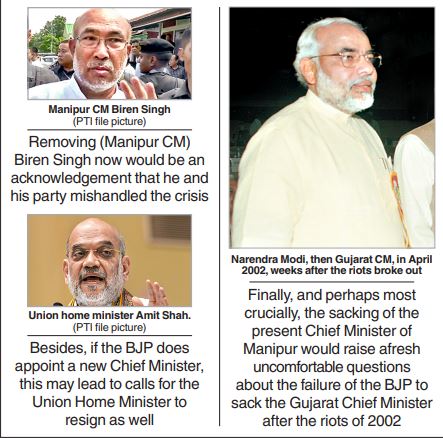
Why Narendra Modi can’t even ask Manipur chief minister N Biren Singh to practise rajdharma
Don't Miss
Given how awful and enduring the violence and suffering have been, and given how little (if anything) the Manipur chief minister has done to stem it, why is he still in office?
TT, 24.07.23 : The history of independent India has been peppered with major and violent conflicts fought on sectarian lines. These have broadly been of two types.
The first are armed insurgencies demanding secession or independence, as took place in the Naga and Mizo hills in the 1950s and 1960s, and in Punjab and the Kashmir Valley in the 1980s and 1990s.
The second is majoritarian violence within a particular Indian state or Union Territory, as, for instance, the pogrom against Sikhs in Delhi in 1984 and against Muslims in Gujarat in 2002, both led by Hindu mobs, and the purging of Pandits in Kashmir in 1989-90, led by Islamist jihadists.
In the past, Manipur had witnessed the first form of conflict, with armed Meitei insurgents demanding a nation of their own, and armed Nagas seeking the formation of a nation with the contiguous districts of Nagaland. The present conflict, however, is internal to the state; it is between two of its ethnic groups, the Meiteis and the Kukis. Neither side is demanding independence from India.
A comparison of the inter-communal conflict in Manipur today with similar conflicts in other Indian states in the past may be instructive.
At one level, there are significant differences. One is the proportionately greater availability of armed weapons among the combatants on both sides in Manipur. Naxalites in central India or dacoits in northern India may have occasionally raided a particular police station; but the widespread looting of police armouries recently witnessed in Manipur perhaps has no parallel in Indian history. Pakistan may have armed jihadists in Kashmir and the Indian state may have looked on as Hindus with swords and fire bombs attacked Muslims in Gujarat or Sikhs in Delhi.
However, in Manipur today, both parties to the conflict are well-equipped with deadly weapons, leading to a substantial escalation of the violence.
The second major difference has to do with the extreme territorial separation that the conflict has produced. Before May 2023, the number of Meiteis in the hill districts and the number of Kukis in the Imphal Valley were not insignificant.
But now the majority in each region seeks to reduce the minority to a state of non-existence. It is true that there is a strict, and deeply depressing, residential segregation of Muslims and Hindus in cities like Ahmedabad, yet in Manipur the separation is more far-reaching in both a geographical and social sense. In Gujarat, radical Hindus want to keep Muslims in a state of permanent subjection; in Manipur, many Meiteis and Kukis never want even to see each other again.
Yet there are some significant parallels too. The first is with regard to violence against women, which has been as savage in Manipur in 2023 as it was in Gujarat in 2002. The second has to do with the fact that, in both states, the political establishment, in general, and the Chief Minister, in particular, have taken the side of, or been identified with, the majority community.
In Manipur, Meiteis comprise 53 per cent of the population, Kukis, 16 per cent (the third major group, the Nagas, account for 24 per cent). In Gujarat, Hindus comprise 88 per cent of the population, Muslims, a mere 10 per cent. The ratio of majority to minority is thus roughly 3.3: 1 in the first instance and roughly 8.8:1 in the second.
The relationship is relatively less asymmetrical in Manipur, which might explain why the violence has not been as one-sided as in Gujarat in 2002. (The fact that the violence has also been more intensive is explained by the greater availability of modern weapons, whether looted or bought.)
The relationship between majority and minority in Manipur might not be as asymmetrical as in Gujarat, but it is asymmetrical nonetheless. In any fight between schoolboys, one would be delighted to have eight lads for each one of theirs, but content nonetheless to have at least three. The same holds for rival gangs, rival party cadres and rival ethnicities.
Crucially, the relative demographic dominance of Meiteis in Manipur translates into political power. There has usually been a Meitei Chief Minister, and there have usually been more Meitei than Kuki or Naga Ministers, and they are more likely to get important portfolios too.
The present Chief Minister is a Meitei, and not shy of asserting his ethnic identity, either. He has made several explicitly partisan statements in the three months that have passed since the troubles began.
He has tacitly endorsed the partitioning of the state into a Valley section where no Kukis can enter and a Hill section from which Meiteis shall stay away. Law and order is a state subject, and yet the Chief Minister has been unwilling or unable to act to stop the looting of state armouries, the killings of innocent citizens, or the rape of women.
The scars caused by sectarian violence in Punjab, Kashmir and Gujarat in decades past still haven’t properly healed. The outlook in Manipur is even bleaker. The ethnic conflict has caused deep and possibly irreversible damage to the social fabric and political integrity of the state.
The ripple effects are being felt in other states as well, particularly Mizoram, where Kukis are seeking refuge and Meiteis being asked to flee.
Given how awful and enduring the violence and suffering have been, and given how little (if anything) the Manipur Chief Minister has done to stem it, why is he still in office?
It is not only Opposition MPs in Parliament who are asking this question; every citizen who seeks peace and harmony in our land is asking it too. The Chief Minister should have been sacked weeks ago, yet he remains in power, with the endorsement of his bosses in the BJP and the Central Government.
One important reason that Biren Singh remains in office is the Modi regime’s absolute refusal to admit that they have ever been at fault. Their record in office must be always presented as blameless.
The economic costs of the demonetization, the social suffering caused by unplanned lockdowns during Covid, the encroachment by the Chinese army into thousands of square kilometres of territory claimed by India — all these costly failures have not led to any changes in policy or personnel.
The ruling duo of the BJP might occasionally change a Chief Minister in mid-stream if they think he is an electoral liability. However, removing Biren Singh now would be an acknowledgement that he and his party mishandled the crisis.
Besides, if the BJP does appoint a new Chief Minister, this may lead to calls for the Union Home Minister to resign as well. In my view, this would be a legitimate demand. The Home Minister made one trip to Manipur but doesn’t seem to have a proper grip on the situation. However, his proximity to the Prime Minister means that his party would do everything to protect Mr Shah.
Finally, and perhaps most crucially, the sacking of the present Chief Minister of Manipur would raise afresh uncomfortable questions about the failure of the BJP to sack the Gujarat Chief Minister after the riots of 2002.
As is well known, after chastising him for his abandonment of “rajdharma”, Prime Minister Atal Bihari Vajpayee wanted to replace Narendra Modi as Chief Minister, yet was persuaded not to do so by his senior colleagues in the Cabinet, such as Arun Jaitley and L.K. Advani.
The parallels between Gujarat then and Manipur now run ever so close to the bone. Because of his own complicated past, the current Prime Minister cannot ask for the replacement of the Manipur Chief Minister. He cannot even ask him to practise his rajdharma.
As I have argued above, the situation in Manipur today is more grave than that faced in Punjab in the 1980s, in Jammu and Kashmir in the 1990s, in Gujarat in the 2000s.
To begin to heal the rift between communities at present implacably opposed to one other, to begin to restore social trust and the authority of the state, a mandatory first step must be the replacement of the current Chief Minister. Both morality and pragmatism demand the sacking of Biren Singh.
Tragically, this is unlikely to happen, because the man enjoys the protection, albeit for different reasons, of the two most powerful men in the country, the Prime Minister and the Home Minister of India.



0 Response to "Why Narendra Modi can’t even ask Manipur chief minister N Biren Singh to practise rajdharma"
Post a Comment
Disclaimer Note:
The views expressed in the articles published here are solely those of the author and do not necessarily reflect the official policy, position, or perspective of Kalimpong News or KalimNews. Kalimpong News and KalimNews disclaim all liability for the published or posted articles, news, and information and assume no responsibility for the accuracy or validity of the content.
Kalimpong News is a non-profit online news platform managed by KalimNews and operated under the Kalimpong Press Club.
Comment Policy:
We encourage respectful and constructive discussions. Please ensure decency while commenting and register with your email ID to participate.
Note: only a member of this blog may post a comment.